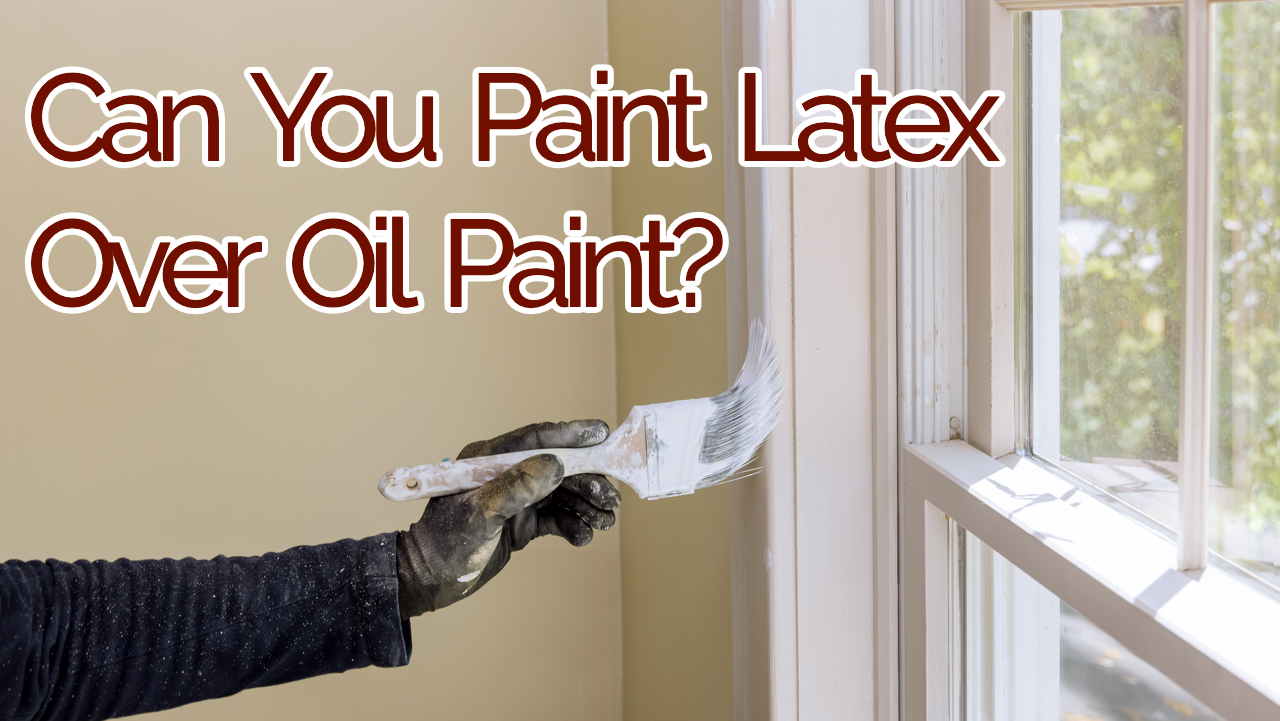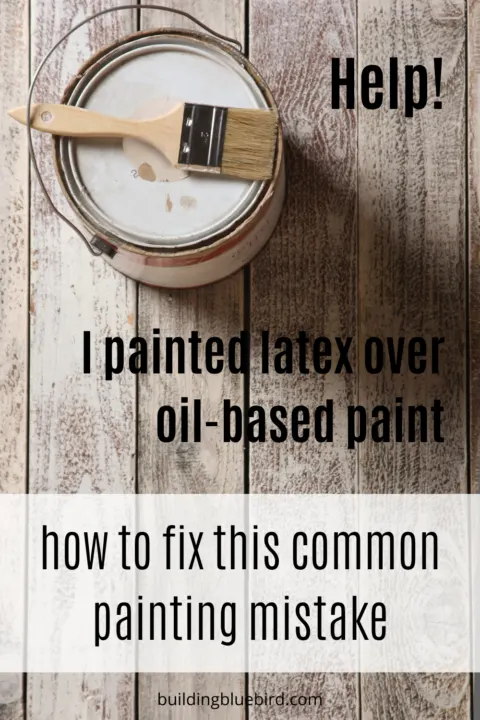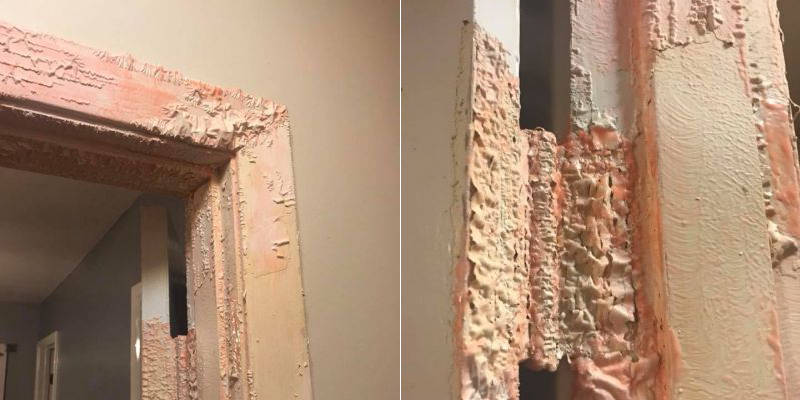Yes, oil-based paint can be used over latex paint. However, it is important to properly prepare the surface and use the appropriate primer to ensure proper adhesion.
Oil-based paint takes longer to dry and has a strong odor, so proper ventilation is necessary during application and drying. When considering painting a surface, it’s important to know what types of paint can be used together. One common question is whether oil-based paint can be used over latex paint.
The short answer is yes, but it’s important to take the necessary steps to ensure proper adhesion. This includes cleaning and sanding the surface, using a bonding primer, and allowing for proper drying time. It’s also important to note that oil-based paint has a longer drying time and stronger odor, so proper ventilation is crucial. With proper preparation and technique, painting with oil-based paint over latex can be a successful project.
Contents
Introduction To Paint Compatibility
Challenges With Oil And Latex Paints
When using oil-based paint over latex, there are significant challenges to consider. The primary issue arises from the incompatibility between the two types of paint. Oil-based paint tends to repel latex paint, leading to poor adhesion and potential peeling or flaking. This can result in an uneven finish and compromised durability. Additionally, the drying time and curing process of oil-based paint differ from that of latex, further complicating the compatibility between the two.
Importance Of Proper Surface Preparation
Proper surface preparation is crucial for ensuring the successful application of oil-based paint over latex. Thoroughly cleaning and sanding the existing latex paint surface is essential to promote adhesion. Applying a bonding primer specifically designed to adhere to both latex and oil-based paints can significantly improve compatibility and durability. Additionally, addressing any existing peeling or flaking areas prior to painting is imperative to achieve a smooth and long-lasting finish.
The Basics Of Oil Based Paint
Oil-based paint is a type of paint that uses an oil-based solvent as a binder. It has been a popular choice for many years due to its durability and smooth finish. Let’s delve into its composition, characteristics, advantages, and limitations.
Composition And Characteristics
Oil-based paint is composed of pigments, a solvent (typically mineral spirits or paint thinner), and a binder, which is usually linseed oil or alkyd resin. This composition gives it a glossy and durable finish, making it suitable for high-traffic areas.
Advantages And Limitations
Advantages:
- Excellent adhesion to various surfaces
- Durable and resistant to wear and tear
- Provides a smooth and glossy finish
Limitations:
- Strong odor and fumes during application
- Requires longer drying time
- Not environmentally friendly due to high VOC content
Understanding Latex Paint
Yes, you can use oil-based paint over latex paint, but it’s important to properly prepare the surface beforehand. Start by sanding the latex paint to create a rough texture, and then apply a bonding primer before adding the oil-based paint to ensure proper adhesion.
This will help the new paint adhere effectively and provide a long-lasting finish.
Water-based Formulation
Latex paint, also known as water-based paint, is a popular choice for both interior and exterior applications. Its formulation consists of pigments, binders, and water as the primary solvent. The water content allows for easy application and cleanup, making it a convenient choice for DIY enthusiasts and professional painters alike.
Benefits And Drawbacks
Using latex paint comes with several benefits. Firstly, it dries relatively quickly, allowing for faster completion of painting projects. This is particularly advantageous when time is of the essence or when working on multiple coats. Additionally, latex paint emits fewer harmful fumes compared to oil-based alternatives, making it a safer option for indoor use.
Furthermore, latex paint is known for its durability and resistance to cracking, peeling, and fading. This makes it suitable for high-traffic areas or surfaces exposed to harsh weather conditions. Its flexibility also allows it to expand and contract with temperature changes, reducing the risk of paint damage.
However, there are some drawbacks to consider when using latex paint. One of the main limitations is that it may not adhere well to certain surfaces, such as glossy or oil-based finishes. In such cases, proper surface preparation, such as sanding or priming, is necessary to ensure proper adhesion.
Latex paint is also more susceptible to water damage compared to oil-based paint. Although it is water-resistant to some extent, prolonged exposure to moisture can cause the paint to soften or even peel. Therefore, it may not be the best choice for areas prone to excessive humidity or water splashes, such as bathrooms or kitchens.
Overall, latex paint offers numerous benefits, including easy application, quick drying time, and low VOC emissions. However, it is important to consider its limitations and suitability for specific surfaces or environments. Understanding these factors will help you make an informed decision when deciding between latex and oil-based paints.
Prepping The Surface
Prepping the surface is crucial before applying oil-based paint over latex. It involves thorough cleaning, sanding, and priming to ensure proper adhesion and a smooth finish. Following these steps will help you achieve long-lasting and professional-looking results.
Cleaning And Sanding
To ensure proper adhesion of the oil-based paint over latex, it is crucial to thoroughly clean and sand the surface. Cleaning the surface removes any dirt, dust, or grease that may hinder the paint’s ability to stick. Using a mild detergent and water solution, scrub the surface gently, then rinse and let it dry completely.
Once the surface is clean, sanding becomes essential to create a rough texture that allows the oil-based paint to grip onto the latex. Use fine-grit sandpaper and lightly sand the entire surface, focusing on any glossy areas. This process helps to remove any existing sheen and provides a better bonding surface for the oil-based paint.
Applying Primer
Applying a suitable primer is a crucial step when using oil-based paint over latex. The primer acts as a bridge between the two different types of paints and ensures proper adhesion. It also helps to seal the surface and prevent any bleed-through or discoloration.
Choose a high-quality oil-based primer specifically designed for use over latex surfaces. Apply the primer evenly using a brush or roller, following the manufacturer’s instructions. Allow the primer to dry thoroughly before proceeding with the oil-based paint application.
Application Techniques
Yes, you can use oil-based paint over latex, but proper application is crucial. Before starting, ensure the surface is clean and lightly sanded. Apply a high-quality primer to promote adhesion, then paint with oil-based paint using a high-quality brush or roller for a smooth finish.
When it comes to painting, choosing the right application technique is just as important as choosing the right paint. If you are wondering whether you can use oil-based paint over latex, the answer is yes, but it requires careful preparation and application techniques. In this section, we will cover the different techniques you can use to apply oil-based paint over latex.
Brush Vs. Roller
The first decision you need to make is whether to use a brush or a roller to apply the paint. A brush is best for small areas and cutting in around edges. A roller is better for large areas, such as walls and ceilings. When using a brush, use a high-quality brush with natural bristles. Synthetic brushes are not recommended for oil-based paints. When using a roller, use a high-quality roller cover with a nap length appropriate for the surface you are painting.
Spraying Methods
Spraying is another option for applying oil-based paint over latex. This method is best suited for large areas and provides a smooth, even finish. However, it requires special equipment and careful preparation to avoid overspray. Before using a sprayer, mask off any areas you do not want to paint, such as windows and doors. Use a high-quality sprayer and follow the manufacturer’s instructions for thinning the paint and adjusting the spray pattern.
Preparation Techniques
Regardless of the application technique you choose, proper preparation is essential when painting with oil-based paint over latex. Start by cleaning the surface thoroughly to remove any dirt, grease, or loose paint. Sand the surface lightly to create a rough texture that will help the paint adhere. Apply a high-quality primer designed for use with both oil-based and latex paints. Allow the primer to dry completely before applying the topcoat.
In conclusion, when it comes to applying oil-based paint over latex, choosing the right application technique is key. Whether you choose to use a brush, roller, or sprayer, proper preparation and technique are essential for a smooth, long-lasting finish.

Credit: thecraftsmanblog.com
Potential Problems And Solutions
Potential Problems and Solutions: While oil-based paint is known for its durability and smooth finish, it can be tricky to apply over latex paint. One of the major concerns is the adhesion of the oil-based paint over the latex paint. However, with the right preparation and technique, you can successfully use oil-based paint over latex paint. In this article, we will discuss the potential problems and solutions that you may encounter when using oil-based paint over latex paint.
Adhesion Issues:
Adhesion issues are one of the most common problems that people face when using oil-based paint over latex paint. Latex paint has a smooth and non-porous surface, which makes it difficult for oil-based paint to adhere to it. As a result, the paint may peel or flake off over time. To ensure proper adhesion, you need to prepare the surface by cleaning it thoroughly and applying a coat of primer specifically designed for oil-based paint.
Cracking And Peeling:
Another problem that you may encounter when using oil-based paint over latex paint is cracking and peeling. This usually happens when the oil-based paint dries too quickly and shrinks, causing it to crack and peel off. To prevent this from happening, you need to apply thin coats of paint and wait for each coat to dry completely before applying the next one. You should also avoid painting in extreme temperatures or humidity, as this can affect the drying time and lead to cracking and peeling.
Overall, using oil-based paint over latex paint can be a challenge, but it is possible with the right preparation and technique. By addressing the potential problems and solutions discussed in this article, you can achieve a smooth and durable finish that will last for years to come.
Expert Tips For Successful Coverage
When it comes to painting projects, achieving a smooth and even finish is key to a successful outcome. If you’re wondering whether you can use oil-based paint over latex, the answer is yes, but there are a few important considerations to keep in mind. In this article, we’ll provide you with expert tips to ensure your coverage is successful.
Test Patch Advice
Before committing to painting an entire surface, it’s always a good idea to conduct a test patch. This will allow you to evaluate how well the oil-based paint adheres to the existing latex paint. Choose an inconspicuous area and apply a small amount of oil-based paint. Let it dry completely and then assess the results. If the paint adheres well and provides a smooth finish, you can proceed with confidence.
Layering Strategies
Layering is an important technique when using oil-based paint over latex. To ensure successful coverage, follow these layering strategies:
- Prepare the surface by cleaning it thoroughly and removing any loose or peeling paint.
- Apply a primer specifically designed for oil-based paints. This will help promote adhesion and prevent any compatibility issues between the latex and oil-based paints.
- Once the primer has dried, apply the oil-based paint in thin, even coats. Avoid applying too much paint at once, as this can lead to drips and uneven coverage.
- Allow each coat to dry completely before applying the next layer. This will help achieve a smooth and durable finish.
By following these layering strategies, you can ensure that your oil-based paint adheres well to the latex surface, providing a long-lasting and professional-looking result.

Credit: buildingbluebird.com
Maintenance And Care
Proper maintenance and care of painted surfaces are essential for preserving their beauty and longevity. Whether you are considering using oil-based paint over latex or vice versa, following the right cleaning and touch-up recommendations will ensure your painted surfaces stay looking fresh and vibrant for years to come.
Cleaning Painted Surfaces
To maintain the cleanliness of your painted surfaces, it is important to use the appropriate cleaning methods. Here are some tips to keep in mind:
- Regularly dust your painted surfaces using a soft, lint-free cloth to remove any loose dirt or debris.
- If the surface requires further cleaning, mix a mild detergent with warm water and gently scrub the area using a soft sponge or brush.
- Avoid using abrasive cleaners or scrubbing too vigorously, as this can damage the paint finish.
- After cleaning, rinse the surface thoroughly with clean water and dry it with a soft towel or cloth.
Touch-up Recommendations
Over time, painted surfaces may experience minor wear and tear, such as scratches or scuff marks. Here are some touch-up recommendations to maintain the appearance of your paint:
- Start by cleaning the affected area using the cleaning methods mentioned above to ensure a clean surface for touch-ups.
- If the paint has chipped or peeled, gently sand the damaged area with fine-grit sandpaper to create a smooth surface.
- Wipe away any dust or debris using a soft cloth or brush.
- Apply a small amount of the appropriate paint (oil-based or latex) to the damaged area using a brush or roller, following the manufacturer’s instructions.
- Allow the touch-up paint to dry completely before assessing the color match and applying additional coats if necessary.
By following these cleaning and touch-up recommendations, you can maintain the beauty of your painted surfaces, regardless of whether you choose to use oil-based paint over latex or vice versa. Remember to always consult the manufacturer’s guidelines for specific care instructions and enjoy the long-lasting results of your paint job.
Case Studies
Real-life Examples
Case Study 1: A homeowner in a coastal area applied latex paint to their exterior siding. After a few years, they decided to switch to oil-based paint for better durability against the harsh weather conditions. The new paint adhered well, and the siding looked rejuvenated.
Case Study 2: A property manager wanted to update the interior walls of an apartment complex. Despite the existing latex paint, they opted for oil-based paint due to its stain resistance. The application process was smooth, and the new paint enhanced the overall appeal of the units.
Professional Insights
Professional painters often encounter scenarios where they need to apply oil-based paint over existing latex surfaces. According to industry experts, thorough surface preparation is crucial to ensure proper adhesion. This typically involves cleaning, sanding, and priming the latex surface to create an ideal foundation for the oil-based paint.
Additionally, professionals recommend conducting a compatibility test in a small inconspicuous area to confirm the adhesion and compatibility of the oil-based paint over the latex surface.

Credit: www.h2ouse.org
Frequently Asked Questions
What Happens If You Put Oil-based Over Latex?
Mixing oil-based paint and latex paint will result in a peeling and cracking surface. The oil-based paint won’t adhere to the latex paint properly and will separate from it over time. It’s crucial to use the same type of paint for the base and topcoat to ensure a durable and long-lasting finish.
Can You Paint Over Water-based Paint With Oil-based Paint?
Yes, you can paint over water-based paint with oil-based paint. However, it is important to prepare the surface properly by sanding and priming before painting. Using an oil-based primer can help the new paint adhere better to the surface. It is also important to note that oil-based paint takes longer to dry and may have a stronger odor compared to water-based paint.
How To Prep Oil-based Paint For Latex?
Sand the oil-based paint surface, clean it thoroughly, and apply a suitable primer before using latex paint.
Why Is Oil-based Paint Better Than Latex?
Oil-based paint is superior to latex because it provides a more durable and long-lasting finish. It is resistant to stains, moisture, and wear and tear. Additionally, it offers better adhesion to surfaces and covers imperfections more effectively. Its high gloss finish adds a touch of elegance to any project.
Conclusion
Using oil-based paint over latex is possible with proper preparation. Ensure the surface is clean and primed for best results. Consider the compatibility of the paints and use a bonding primer if needed. Always test a small area first. Following these steps will help you achieve a successful paint job.
